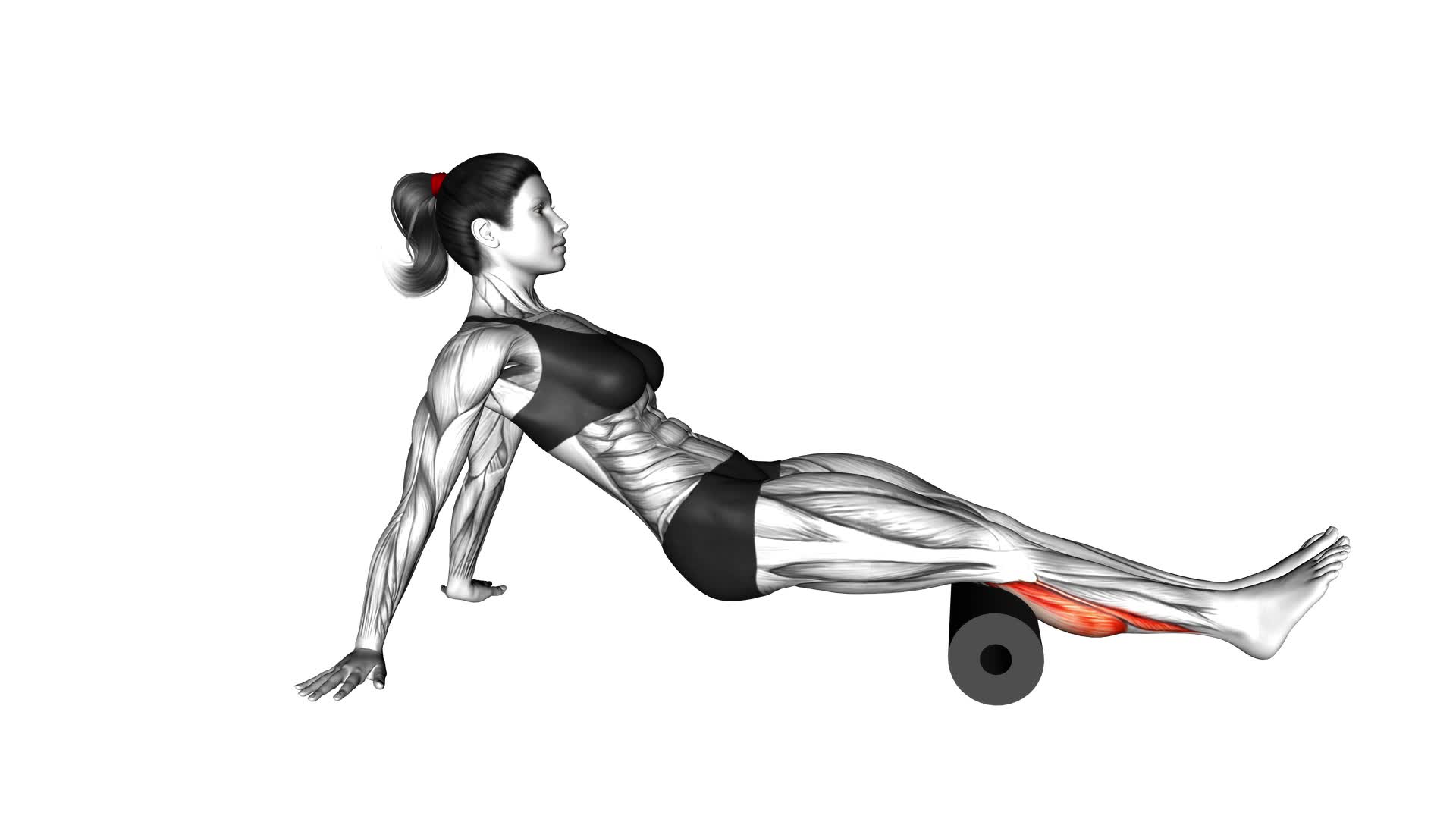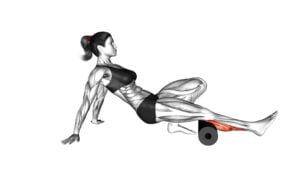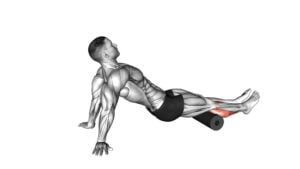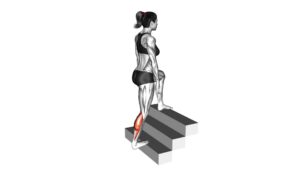Roll Calves (female) – Video Exercise Guide & Tips

Get ready to strengthen and tone your calves with our video exercise guide for roll calves. In this article, we'll show you the proper form and technique. We'll also provide variation and progression options, and offer tips for maximizing your results.
Watch This Exercise Video
Avoid common mistakes and get the most out of your calf workouts. Let's get started!
Key Takeaways
- Roll calves exercise targets and strengthens calf muscles essential for walking, running, and jumping.
- It improves lower body stability, reducing the risk of ankle and foot injuries.
- Roll calves exercise enhances overall leg strength, improving performance in sports and daily tasks.
- It promotes better balance, which is especially important for older adults.
Benefits of Roll Calves Exercise
Discover the benefits you can gain from incorporating roll calves exercise into your fitness routine.
Roll calves exercise offers numerous health benefits, especially when it comes to muscle strengthening. This exercise specifically targets the calf muscles, which are essential for walking, running, and jumping. By regularly performing roll calves exercise, you can effectively strengthen and tone your calf muscles, enhancing their power and endurance.
One of the key health benefits of roll calves exercise is improved lower body stability. Strong calf muscles help stabilize your ankles and feet, reducing the risk of injuries such as sprains and strains. Additionally, this exercise promotes better balance, which is especially important for older adults who may be more prone to falls.
Roll calves exercise also contributes to better overall leg strength. The calf muscles play a crucial role in supporting the weight of your body during various activities. Strengthening these muscles not only improves your performance in sports and fitness activities but also helps with everyday tasks such as climbing stairs or lifting heavy objects.
Incorporating roll calves exercise into your fitness routine can have a positive impact on your health and well-being. By strengthening your calf muscles, you can enhance your lower body stability, improve leg strength, and reduce the risk of injuries.
Proper Form and Technique
To perform the roll calves exercise with proper form and technique, follow these instructions.
- Start by positioning yourself on a mat or a soft surface, lying face down with your legs extended.
- Place a foam roller underneath your calves, just above your ankles.
- Now, using your arms and core strength, lift your body off the ground, supporting your weight on your forearms and the foam roller. Your elbows should be directly underneath your shoulders. Keep your body in a straight line from your head to your heels.
Engage your core and glutes to maintain stability throughout the exercise.
- Slowly roll the foam roller up towards your knees, using controlled movements. You should feel a deep stretch in your calves.
- Pause for a moment at the top, then slowly roll back down to the starting position.
By performing the roll calves exercise with proper form and technique, you can prevent injuries and ensure optimal muscle activation.
It's important to maintain a neutral spine and avoid any excessive arching or rounding of the back.
Focus on using your calves to control the movement and maintain stability.
Now that you know how to perform the roll calves exercise correctly, let's explore some variation and progression options to challenge yourself even further.
Variation and Progression Options
To challenge yourself even further and continue progressing in the roll calves exercise, you can try incorporating different variations and techniques. Progression options for the roll calves exercise include increasing the speed of the movement, adding resistance by holding dumbbells or using a barbell, or performing the exercise on an unstable surface such as a balance board or a foam pad. These variations will increase the difficulty of the exercise and help to further strengthen your calf muscles.
Modification options are also available if you find the roll calves exercise too challenging. You can start by performing the exercise with your knees bent instead of straight, which will decrease the range of motion and make it easier to control the movement. Another modification option is to perform the exercise with one leg at a time instead of both legs together. This will help you focus on each calf individually and allow you to gradually build strength.
Common Mistakes to Avoid
Are you making any common mistakes while performing the roll calves exercise? Avoiding injuries and understanding the importance of a warm-up are crucial for a successful workout.
When it comes to the roll calves exercise, there are a few common mistakes you should avoid to ensure you get the most out of your workout and reduce the risk of injury.
Firstly, it's important to warm up before starting any exercise routine. This helps increase blood flow to the muscles, improving their flexibility and reducing the risk of strains or pulls. Skipping the warm-up can lead to muscle tightness and potential injuries during the roll calves exercise.
Another common mistake is using excessive weight. While it's important to challenge yourself, using too much weight can put excessive strain on your calf muscles, leading to muscle imbalances or even muscle tears. Start with a weight that allows you to perform the exercise with proper form and gradually increase the weight as you get stronger.
Lastly, rushing through the exercise is a common mistake to avoid. Performing the roll calves exercise with proper form and control is essential for targeting the calf muscles effectively. Take your time during each repetition, focusing on the contraction and extension of the calf muscles.
Tips for Maximizing Results
To maximize your results with the roll calves exercise, focus on proper form and gradually increasing the weight as you get stronger. Here are some additional tips to help you get the most out of your workouts:
- Diet tips: Eating a balanced diet that includes lean proteins, healthy fats, and complex carbohydrates can provide your body with the necessary nutrients for muscle growth and recovery. Make sure to stay hydrated throughout the day as well.
- Recovery strategies: Giving your muscles enough time to rest and recover is crucial for maximizing results. Incorporate rest days into your workout routine and consider adding activities like stretching or foam rolling to improve flexibility and reduce muscle soreness.
- Progressive overload: As you become more comfortable with the roll calves exercise, gradually increase the weight or intensity to challenge your muscles. This progressive overload stimulates muscle growth and strength gains over time.
- Listen to your body: Pay attention to any discomfort or pain during the exercise. If something doesn't feel right, modify the exercise or consult with a fitness professional to ensure proper form and prevent injuries.
Frequently Asked Questions
How Many Calories Can Be Burned by Doing Roll Calves Exercises?
Rolling calves exercises can help you burn calories effectively. The number of calories burned depends on various factors such as your weight, intensity, and duration of the exercise. It's difficult to provide an exact number without the context of the specific exercise.
However, incorporating roll calves exercises into your fitness routine can contribute to calorie burning benefits. To maximize results, it's recommended to perform these exercises at an optimal frequency that suits your fitness level and goals.
Can Roll Calves Exercises Help in Reducing Cellulite?
Roll calves exercises are a great addition to any workout routine. They target the calves and can help strengthen and tone the muscles in that area. While they may not directly reduce cellulite, incorporating these exercises into a regular workout routine can contribute to overall fat loss and improved muscle tone, which can help minimize the appearance of cellulite.
Remember to consult with a healthcare professional before starting any new exercise program, especially during pregnancy.
Is It Safe to Perform Roll Calves Exercises if I Have a Knee Injury?
Performing roll calves exercises with a knee injury may not be safe. It's important to prioritize your health and recovery. Instead, focus on exercises that are gentle on your knees, such as swimming or stationary cycling. These exercises can still help improve leg strength and flexibility.
Consult with a healthcare professional or physical therapist for modifications and alternatives that are suitable for your specific injury. Safety should always come first during your fitness journey.
Can Roll Calves Exercises Help in Improving Balance and Stability?
Roll calves exercises can indeed help improve your balance and stability. By engaging the muscles in your calves, these exercises promote ankle mobility, which is crucial for maintaining balance.
Additionally, roll calves exercises can also help prevent shin splints, a common issue that can affect your stability during physical activities.
Incorporating these exercises into your routine can provide you with the stability and balance you need for various activities, such as sports or everyday movements.
How Often Should Roll Calves Exercises Be Performed to See Results?
To see results from roll calves exercises, it's important to perform them with a certain frequency. The best time to do these exercises is generally two to three times a week. This will allow your calves to recover between sessions and prevent overtraining.
Consistency is key, so make sure to stick to a regular schedule. By incorporating roll calves exercises into your routine at the right frequency, you can effectively strengthen and improve the flexibility of your calf muscles.
Conclusion
In conclusion, the roll calves exercise is a beneficial and effective way to strengthen and tone the calf muscles.
By performing the exercise with proper form and technique, and incorporating variations and progressions, you can maximize your results.
Avoid common mistakes and follow the tips provided to ensure optimal outcomes.
Incorporate roll calves into your workout routine to achieve stronger and more defined calves.

Author
Years ago, the spark of my life’s passion ignited in my mind the moment I stepped into the local gym for the first time. The inaugural bead of perspiration, the initial endeavor, the very first surge of endorphins, and a sense of pride that washed over me post-workout marked the beginning of my deep-seated interest in strength sports, fitness, and sports nutrition. This very curiosity blossomed rapidly into a profound fascination, propelling me to earn a Master’s degree in Physical Education from the Academy of Physical Education in Krakow, followed by a Sports Manager diploma from the Jagiellonian University. My journey of growth led me to gain more specialized qualifications, such as being a certified personal trainer with a focus on sports dietetics, a lifeguard, and an instructor for wellness and corrective gymnastics. Theoretical knowledge paired seamlessly with practical experience, reinforcing my belief that the transformation of individuals under my guidance was also a reflection of my personal growth. This belief holds true even today. Each day, I strive to push the boundaries and explore new realms. These realms gently elevate me to greater heights. The unique combination of passion for my field and the continuous quest for growth fuels my drive to break new ground.



